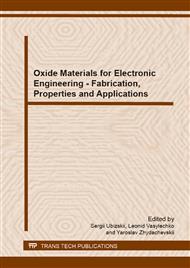[1]
X. Zhang, B. Bureau, P. Lucas, C. Boussard-Pledel and J. Lucas, Glasses for seeing beyond visible, Chem. Eur. J. 14 (2008) 432–442.
DOI: 10.1002/chem.200700993
Google Scholar
[2]
J.S. Sanghera and I.D. Aggarwal, Active and passive chalcogenide glass optical fibers for IR applications: a review, J. Non-Cryst. Solids 256-257 (1999) 6–16.
DOI: 10.1016/s0022-3093(99)00484-6
Google Scholar
[3]
R. Golovchak, A. Kozdras and O. Shpotyuk, Optical signature of structural relaxation in glassy As10Se90, J. Non-Cryst. Sol. 356 (2010) 1149–1152.
DOI: 10.1016/j.jnoncrysol.2010.04.008
Google Scholar
[4]
H. Ticha, L. Tichy, P. Nagels, E. Sleeckx and R. Callaerts, Temperature dependence of the optical gap in thin amorphous films of As2S3, As2Se3 and other basic non-crystalline chalcogenides, J. Phys. Chem. Solids 61 (2000) 545–550.
DOI: 10.1016/s0022-3697(99)00249-8
Google Scholar
[5]
Y. Wang, P. Boolchand and M. Micoulaut, Glass structure, rigidity transitions and the intermediate phase in the Ge-As-Se ternary, Europhys. Letters 52 (2000) 633–639.
DOI: 10.1209/epl/i2000-00485-9
Google Scholar
[6]
M.F. Thorpe, Continuous deformations in random networks, J. Non-Cryst. Solids 57 (1983) 355–370.
DOI: 10.1016/0022-3093(83)90424-6
Google Scholar
[7]
D.G. Georgiev, P. Boolchand and M. Micoulaut, Rigidity transitions and molecular structure of AsxSe1-x glasses, Phys. Rev. B 62 (2000) R9228–R9231.
Google Scholar
[8]
P. Boolchand, X. Feng and W.J. Bresser, Rigidity transitions in binary Ge-Se glasses and the intermediate phase, J. Non-Cryst. Sol. 293-295 (2001) 348–356.
DOI: 10.1016/s0022-3093(01)00867-5
Google Scholar
[9]
R. Golovchak, H. Jain, O. Shpotyuk, A. Kozdras, A. Saiter and J.-M. Saiter, Experimental verification of the reversibility window concept in binary As-Se glasses subjected to a long-term physical aging, Phys. Rev. B 78 (2008) 014202-1–6.
DOI: 10.1103/physrevb.78.014202
Google Scholar
[10]
R. Golovchak, A. Kozdras, O. Shpotyuk, S. Kozyukhin and J.-M. Saiter, Long-term ageing behaviour in Ge–Se glasses, J. Mater. Sci. 44 (2009) 3962–3967.
DOI: 10.1007/s10853-009-3540-6
Google Scholar
[11]
R. Golovchak, A. Kozdras and O. Shpotyuk, On the reversibility window in binary As–Se glasses, Phys. Letters A 370 (2007) 504–508.
DOI: 10.1016/j.physleta.2007.05.093
Google Scholar
[12]
A. Ganjoo and R. Golovchak, Computer program PARAV for calculating optical constants of thin films and bulk materials: Case study of amorphous semiconductors, J. Optoelectr. Adv. Mater. 10 (2008) 1328–1332.
Google Scholar
[13]
E. Le Bourhis, P. Gadaud, J.-P. Guin, N. Tournerie, X.H. Zhang, J. Lucas and T. Rouxel, Temperature dependence of the mechanical behaviour of GeAsSe glass Scripta Mater. 45 (2001) 317–323.
DOI: 10.1016/s1359-6462(01)01034-x
Google Scholar


